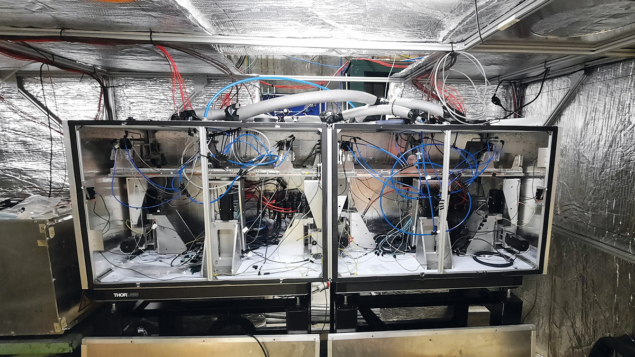
The anomalous magnetic moment of the muon has long exhibited an intriguing tension between experiment and theory. The latest measurement from Fermilab is around 5σ higher than the official Standard Model prediction, but newer calculations based on lattice-QCD reduce the gap significantly. Confusion surrounds how best to determine the leading quantum correction to the muon’s magnetic moment: a process called hadronic vacuum polarisation (HVP), whereby a virtual photon briefly transforms into a hadronic blob before being reabsorbed.
While theorists are working hard to resolve this tension, the MUonE project aims to provide an independent determination of HVP using an intense muon beam from the CERN Super Proton Synchrotron. Whereas HVP is traditionally determined via hadron-production cross sections in e+e– data, or via theory-based estimates from recent lattice calculations, MUonE would make a very precise measurement of the shape of the differential cross section of μ+e– → μ+e– scattering. This will enable a direct measurement of the hadronic contribution to the running of the electromagnetic coupling constant α, which governs the HVP process.
MUonE was first proposed in 2017 as part of the Physics Beyond Colliders initiative, and a test run in 2018 was performed to validate the basic idea of a detector. Following a decision by CERN in 2019 to carry out a three-week long pilot run to validate the experimental idea, the MUonE team collected data at the M2 beamline from 21 August to 10 September 2023, using a 160 GeV/c muon beam fired at atomic electrons in a fixed target located at CERN’s North Area. The main purpose of the run was to verify the system’s engineering and to attempt to measure the leptonic corrections to the running of α, for which an analysis is in progress.
The full experiment would have 40 stations comprising a 1.5 cm thick beryllium target followed by a tracking system, which can measure the scattering angles with high precision; further downstream lies an electromagnetic calorimeter and a muon detector. During the 2023 run, two MUonE stations followed by a calorimeter were installed, and a further tracking station without target was placed upstream of the apparatus to detect the incoming muons; the upstream station, towards the beam and without target, was dedicated to tracking the incoming muons. The next step is to install further detetor stations in stages.
“The original schedule has been delayed, partly due to the COVID pandemic, and the final measurement is expected to be performed after Long Shutdown 3,” explains MUonE collaboration board chair Clara Matteuzzi (INFN Milano Bicocca). “A first stage with a scaled detector, comprising a few stations followed by a calorimeter and a muon identifier, which could provide a very first measurement of HVP with low accuracy and a demonstration of the whole concept before the full final run, is under consideration.”
The overall goal of the experiment is to gather around 3.5 × 1012 elastic scattering events with an electron energy larger than 1 GeV, during three years of data-taking at the M2 beam. This would allow the team to achieve a statistical error of 0.3% and thus make MUonE competitive with the latest HVP results computed by other means. The challenge, however, is to keep the systematic error at the level of the statistical one.
“This successful test run gives MUonE confidence that the final goal can be reached, and we are very much looking forward to submitting the proposal for the full run,” adds Matteuzzi.
Further reading
G Abbiendi 2022 Phys. Scr. 97 054007.
R Pilato 2023 PoS EP-HEP2023 305.








